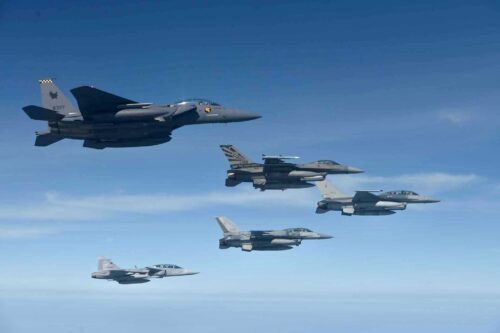This year marks the 30th anniversary of Exercise Cope Tiger, a cornerstone of regional security cooperation in Southeast Asia. The first iteration of this annual trilateral large force aerial exercise took place in 1995, bringing together the United States Air Force (USAF), Royal Thai Air Force (RTAF), and Republic of Singapore Air Force (RSAF) in Thailand.

While the inaugural exercise concluded with a closing ceremony on January 16, 1995, the groundwork for cooperation began months earlier. In August 1994, a command post exercise was held at Paya Lebar Airbase in Singapore, laying the foundation for the subsequent air combat training mission that took place in Thailand.
While the initial 1995 iteration of Cope Tiger featured F-5 Tiger IIs from the RSAF, F-15 Eagles from the USAF, and F-5 Tiger IIs and F-16 Fighting Falcons from the RTAF, the exercise has significantly expanded its scope over the years. Today, a wider range of aircraft reflects the evolving capabilities of the participating air forces. The RSAF now contributes F-16 Fighting Falcons, F-15SG Eagles, and A330 Multi-Role Tanker Transports (MRTT) to the exercise, while the USAF deploys F-16 Fighting Falcons and A-10 Thunderbolt IIs. The RTAF showcases its advancements with the inclusion of Saab JAS 39 Gripens. Beyond fighter jets, the exercise now incorporates various support aircraft such as G550 and E-3 Airborne Early Warning aircraft, which provide crucial situational awareness and command & control capabilities. This expanded participation demonstrates the unwavering commitment of the participating nations to continuously refine their air power capabilities and strengthen interoperability.
This initial collaboration marked the beginning of a long-lasting tradition of joint training, and Cope Tiger has since evolved significantly. Over the past three decades, Cope Tiger has evolved into a premier platform for enhancing interoperability, honing combat skills, and strengthening the bonds between the participating nations. During each exercise, aircrews from all three countries engage in complex scenarios that simulate real-world operations. These scenarios allow participants to practice air combat maneuvers, aerial refueling, close air support, and other critical skills necessary for modern air warfare.
Beyond the tactical benefits, Cope Tiger fosters a spirit of cooperation and understanding among the participating forces. Through joint planning, execution, and debriefing sessions, airmen and women from the US, Thailand, and Singapore build valuable relationships and gain insights into each other’s tactics and procedures.
Despite the impressive evolution, a notable absence remains – fifth-generation fighters like the F-22 and F-35. While cost, operational complexity, and strategic considerations might be factors for their exclusion, their inclusion could offer significant benefits. Their presence would undoubtedly elevate the training experience by introducing the realities of modern air combat, dominated by stealth and advanced sensor capabilities. By encountering and learning to counter these advanced aircraft in a training environment, participating aircrews would hone their skills in crucial areas like stealth detection, situational awareness, and collaborative decision-making. F-22s and F-35s boast superior sensor fusion capabilities, allowing them to integrate information from various sources and present a comprehensive picture of the battlefield. Exposure to these systems would enhance the situational awareness of participating aircrews, allowing them to make better decisions in complex scenarios. Integrating fifth-generation fighters could also necessitate further collaboration on joint tactics and operational procedures, ultimately pushing all participating air forces towards a higher level of interoperability.
Ultimately, the decision to include 5th generation fighters rests with the United States as it is the only nation in the exercise that operates such aircraft. However, one thing remains certain: Cope Tiger’s legacy as a cornerstone of regional cooperation and a platform for air power development remains undeniable. It continues to serve as a testament to the enduring commitment of the participating nations to ensuring stability and promoting peace in Southeast Asia.